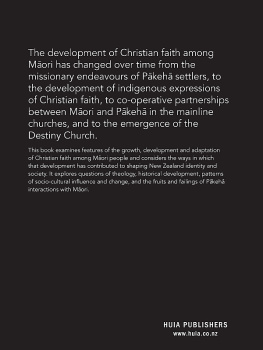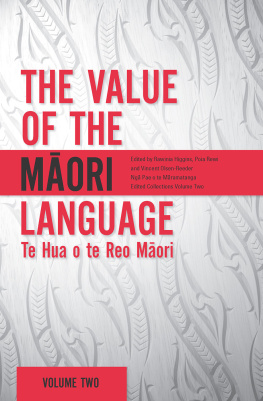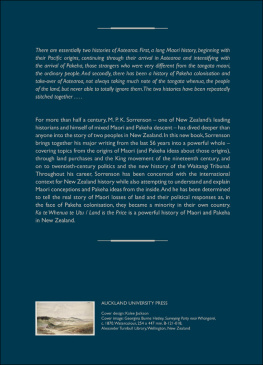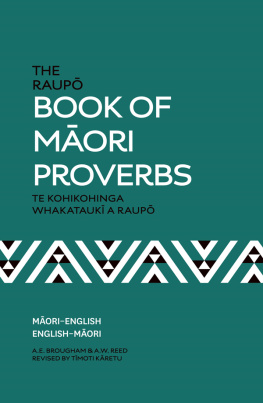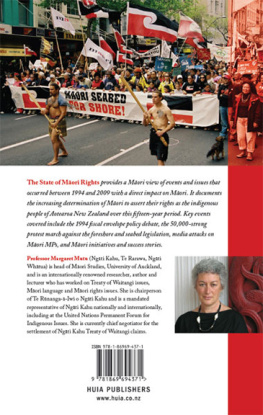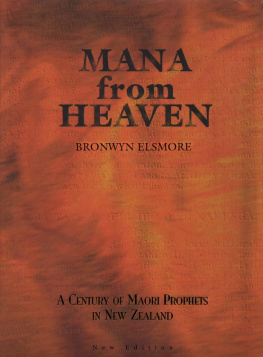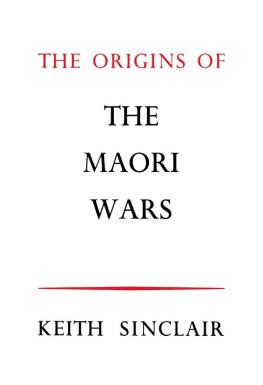M. P. K. Sorrenson - Maori Origins and Migrations
Here you can read online M. P. K. Sorrenson - Maori Origins and Migrations full text of the book (entire story) in english for free. Download pdf and epub, get meaning, cover and reviews about this ebook. year: 1979, publisher: Auckland University Press, genre: Art. Description of the work, (preface) as well as reviews are available. Best literature library LitArk.com created for fans of good reading and offers a wide selection of genres:
Romance novel
Science fiction
Adventure
Detective
Science
History
Home and family
Prose
Art
Politics
Computer
Non-fiction
Religion
Business
Children
Humor
Choose a favorite category and find really read worthwhile books. Enjoy immersion in the world of imagination, feel the emotions of the characters or learn something new for yourself, make an fascinating discovery.

- Book:Maori Origins and Migrations
- Author:
- Publisher:Auckland University Press
- Genre:
- Year:1979
- Rating:4 / 5
- Favourites:Add to favourites
- Your mark:
- 80
- 1
- 2
- 3
- 4
- 5
Maori Origins and Migrations: summary, description and annotation
We offer to read an annotation, description, summary or preface (depends on what the author of the book "Maori Origins and Migrations" wrote himself). If you haven't found the necessary information about the book — write in the comments, we will try to find it.
Maori Origins and Migrations — read online for free the complete book (whole text) full work
Below is the text of the book, divided by pages. System saving the place of the last page read, allows you to conveniently read the book "Maori Origins and Migrations" online for free, without having to search again every time where you left off. Put a bookmark, and you can go to the page where you finished reading at any time.
Font size:
Interval:
Bookmark:
Maori Origins and Migrations
The Genesis of Some Pakeha Myths and Legends
M.P.K. SORRENSON

M. P. K. Sorrenson 1979
First published 1979
Reprinted 1983, 1990
This ebook edition 2013
eISBN 978 1 86940 704 9
Cover: The legend of the voyage to New
Zealand, 1912, reproduction of a painting by
Kennett Watkins in the Auckland City Art
Gallery. Photograph, Alexander Turnbull Library.
For those who are descended from Wairaka, including Tui and Julian
This book is a revised version of my Macmillan Brown lectures, delivered at the University of Auckland in June 1978 under the title Some Modern Maori Myths and Legends. That title was rather misleading since I was concerned with some modern myths and legends about not by Maoris, and the myth-makers I discussed were, for the most part, Pakehas rather than Maoris. This emphasis is indicated in the sub-title of this book. I have examined how Europeans, from Cook to the present day, took up Maori myths and legends and other forms of evidence, and from these attempted to construct theories to explain Maori origins, their migration to the Pacific and to New Zealand, and the culture they brought with them. More often than not the European theorists read into Maori origins and culture what they wanted and expected to find, on the basis of theories derived from their own cultural and philosophical traditions. Though I begin with the explorers, most of the discussion is focused on resident, sometimes locally born, Europeans who were developing what one might call an indigenous intellectual tradition, a specifically New Zealand concern about the origin and racial composition of the Maori. I therefore concentrate on the late-nineteenth, early-twentieth-century period, and particularly on the work of the founding fathers of the Polynesian Society, S. Percy Smith, Edward Tregear, and Elsdon Best.
I should like to thank the trustees of the Macmillan Brown estate for allowing me to publish the lectures; the University of Canterbury library for access to the Macmillan Brown papers; the Alexander Turnbull Library for access to the Polynesian Society, Best, and Ramsden papers; and the University of Auckland library for access to the New Zealand and Pacific collection. The lectures were a considerably expanded version of my essay The Whence of the Maori: some nineteenth century exercises in scientific method, published in The Journal of the Polynesian Society for December 1977. I am grateful to the Polynesian Society for allowing me to re-use this material. I am also grateful to Michael Belgrave for discussions and for drawing my attention to useful material. His M.A. thesis Archipelago of Exiles (Auckland, 1979) which deals more fully with the Aryan theories of Macmillan Brown and Edward Tregear, was completed just as this book went to press. Mrs Agnes Sullivan of the Maori Studies Department at the Victoria University of Wellington kindly read and made many helpful suggestions on the script of the lectures. I have happily adopted her suggestions and corrections. However, I take responsibility for any errors of fact and dubious interpretations that may remain. Since my subject has aroused heated controversy in the past I should not expect to remain immune from criticism. But perhaps I could anticipate one possible complaint. Should any reader remain unhappy that I have not solved the age-long problem of the whence of the Maori, my only reply is that such was not my intention. For this is a study of the quest itself, of the numerous solutions offered by others; an essay on an aspect of New Zealands intellectual history. It is not an attempt to find an original or even a Pacific homeland for the Maori. I leave that task to the many others who are happily engaged on it.
M.P.K. Sorrenson
University of Auckland
February 1979
Europeans have searched for the original homeland of the Maoris since first discovering them. But the search was not a uniquely New Zealand exercise; it was part of the wider quest for the original homeland of all Polynesians. Until recently they were assumed to have migrated as a distinctive race into the Pacific from the Asian mainland and indeed, on the assumption that mankind had diffused from one centre, from a cradleland in the Middle East, or the Caucasus.
Until the publication of Darwins The Origin of Species in 1859 Christian theology, and more particularly the Book of Genesis, provided the orthodox explanation of the origin of man and his dispersal throughout the world. The races of man were said to have descended from the sons of Noah, from Shem, Japheth, and Ham. When new races were discovered in the New World, they were fitted into this classification. The blackest and apparently most primitive of them, like the African negroes and Australian aborigines, were classed as the sons of Ham. But others of lighter hue and more advanced culture, including the American Indians and the Polynesians, were considered to be the sons of Shem. Elaborate theories were constructed to plot their migration by land and sea from the Middle East.
Early speculation about the origin of the Polynesians did not go beyond the bounds of orthodoxy. Jacob Roggeveen, the Dutch navigator, said that the Polynesians were descended from Adam though human understanding [was] powerless to comprehend by what means they could have been transported [to the Pacific]. Such doubts were also to afflict James Cook and his men.
It was not likely to be America, let alone the supposed southern continent, but somewhere in the west.
Cooks subsequent voyages added further speculation which pointed more firmly in the direction of a Malaysian origin for the Polynesians. On the second voyage, Banks was replaced as naturalist by J. R. Forster. It was Forster who anticipated the division of the peoples of the South Pacific into Melanesians and Polynesians; the former a dark-skinned, small-framed people inhabiting the western isles; the latter a handsome, lighter-coloured, large-limbed people in the eastern Pacific. Forster suggested that the Polynesians had come into the Pacific by island-hopping from Malaya. Some had even got as far as New Zealand where they had absorbed an aboriginal people. By the late nineteenth century this was accepted dogma.
In less than six thousand years some races had reached a high state of civilization; others had become isolated and degenerated to primitive savagery. But the missionaries were confident that they could be quickly converted and civilized.

Like the Jews, Marsden wrote, the Maori had a great natural turn for traffic. John Williamss version of Jewish-featured Maoris bargaining with a Jewish trader at the Bay of Islands in the 1840s.
Alexander Turnbull Library
The Reverend Samuel Marsden and other evangelicals had tried but failed to convert the intractable Australian Aborigines.
But the most persuasive advocate of all was the Anglican missionary, Richard Taylor, author of Te Ika a Maui (1855). A critic of evolutionary theory or, as he called it, progressive development doctrine, Taylor saw in the history and traditions of the Maori proof of the alternative theory of degeneration, reflected in their language, material culture, and religion. The beautiful parable of the prodigal son, he said, had its
Next pageFont size:
Interval:
Bookmark:
Similar books «Maori Origins and Migrations»
Look at similar books to Maori Origins and Migrations. We have selected literature similar in name and meaning in the hope of providing readers with more options to find new, interesting, not yet read works.
Discussion, reviews of the book Maori Origins and Migrations and just readers' own opinions. Leave your comments, write what you think about the work, its meaning or the main characters. Specify what exactly you liked and what you didn't like, and why you think so.

